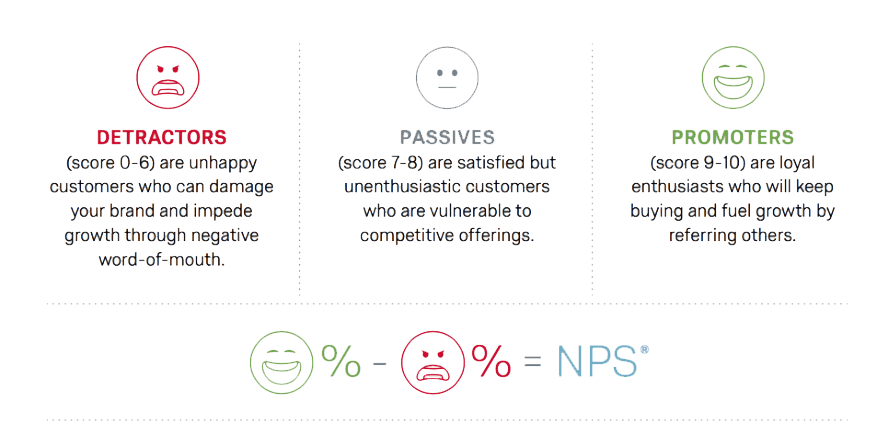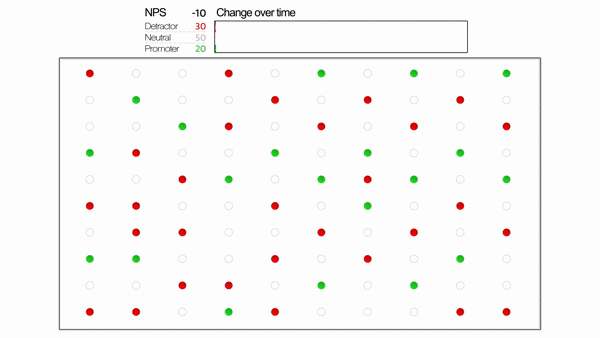What is NPS?
Initially created in 2003 by Bain & Company, NPS has become a standard metric to measure customer loyalty. Bain & Company found that organisations with industry-leading Net Promoter Scores outgrow competing companies by more than double.
NPS gained popularity due to its simplicity. With it, you can calculate loyalty by asking just one question.
While the question is simple, you can use it in multiple contexts and at various frequencies to get many different types of data. Transactional NPS and Relational NPS are two of these variations.
How NPS works
To collect NPS data, you ask your respondents this question:
How likely is it that you would recommend [Organisation X/Product Y/Service Z] to a friend or colleague?

Based on their responses you can categorise your respondents into three categories:
- Respondents who respond with a 9 or 10 and are typically loyal customers.
- Respondents who respond with a 7 or 8 and are happy or indifferent about your product, service, or company
- Respondents with a score of 0 to 6 who are generally disgruntled.
To calculate your NPS score, subtract the percentage of detractors from the percentage of promoters.

New to NPS? You can download a free NPS survey template to use with your Qualtrics account
The graphic below simulates what happens when you turn your detractors into promoters, and the effect it has on your NPS score. The more green there is, the stronger brand loyalty and the more positive the effect is on your business.

What is relational NPS?
Relational NPS is determined by asking your customers how they feel about your organisation overall. Relational NPS gives you a high-level view of customer satisfaction and loyalty. This metric is a good health check of your brand and provides valuable data to compare year-over-year improvement and industry NPS standards.
When to use relational NPS
Relational NPS is ideal when you want to:
- Know the overall perception of your organisation
- Benchmark against internal or external NPS data
- Understand overall customer loyalty
Relational NPS surveys you should be sending
- Annual, 6-monthly or quarterly check-in
It makes sense to collect relational NPS feedback at regular intervals, since there’s no specific trigger event for them. Because you’re looking for a general overview of the relationship, ideally you don’t want the customer to receive the survey when they’re in the midst of a specific experience with you such as a purchase, as it will colour their perspective. If you send your relational NPS survey to everyone at once, make sure it doesn’t coincide with a period of peak sales (such as the holidays).
What is transactional NPS?
While transactional NPS uses the same survey methodology, it aims to address customer satisfaction at a more granular level. Unlike relational NPS, transactional NPS questions elicit feedback after a specific interaction like a support call or after installation. Transactional feedback provides very direct feedback about a particular issue, allowing your organisation to optimise different touchpoints across the customer lifecycle and giving each department a metric to base its actions around.
When to use transactional NPS
Transactional NPS is ideal when you want to:
- Identify strengths or weaknesses for customer interactions
- Create an individual metric for different teams
- Find actionable insights at the transactional level
Transactional NPS surveys you should be sending
Here are some transactional survey examples. This list includes the classic transactional survey touchpoints, but you can send surveys at whichever points of the customer journey NPS data is needed.
- Post-purchase
Send an NPS survey shortly after your customer has taken delivery of the goods or services, but not immediately. Give them some time to use and evaluate – this could be a week or two weeks. - Contact center
It’s common practice to send an NPS question to customers immediately after they’ve been in touch with your contact center and the experience is fresh in their mind. - New customer
Collecting NPS data from a brand new customer can help you assess the customer onboarding process. - Product update or redesign
Send NPS questionnaires when the customer’s experience of your product or service has materially changed in some way and you want to know how well the adjustment has been received. Bear in mind that most people dislike change – to avoid knee-jerk negative responses, give them a few days or weeks to get used to it before you send your questionnaire.
See how your NPS compares against your industry: NPS Industry Benchmark Calculator
Get the right combination to boost your customer experience
Good customer experience programs often use a combination of relational and transactional metrics to better understand customer satisfaction at the macro and micro levels.
Relational NPS and transactional NPS each have their place, and the data they provide helps you to build up a richer picture of how you’re performing. For many businesses, transactional NPS is collected more frequently since it relates to a wide range of experience touchpoints and what it tells you is usually more actionable than relational NPS data.
How to use the data you collect
Relational NPS data gives you an overview of how customers see your brand. Because it’s a single-question metric, you’ll need more information in order to find out what the specific drivers of the customer experience are so that you can take action. You should use relational NPS data alongside other experience metrics like CSAT and CES, and operational metrics like sales figures and website conversions, to help you understand your CX performance.
Transactional NPS data gives you specific information about a customer experience, meaning it’s easier to act on. For example if a customer gives you a poor NPS score after making a purchase, you can do things like following up with that customer to find out what happened, and checking the NPS scores of other customers purchasing the same thing at the same time to learn whether there’s a bigger issue you need to address.
Related NPS resources:
eBook: Design Your First Transactional NPS® Project